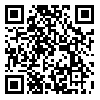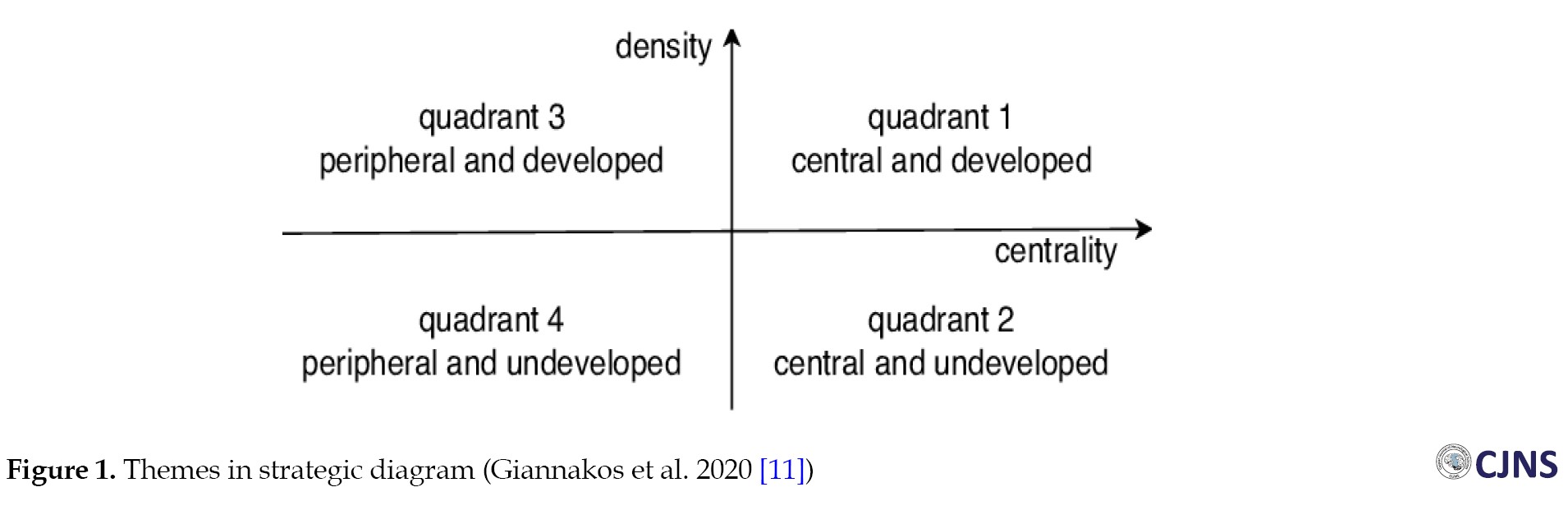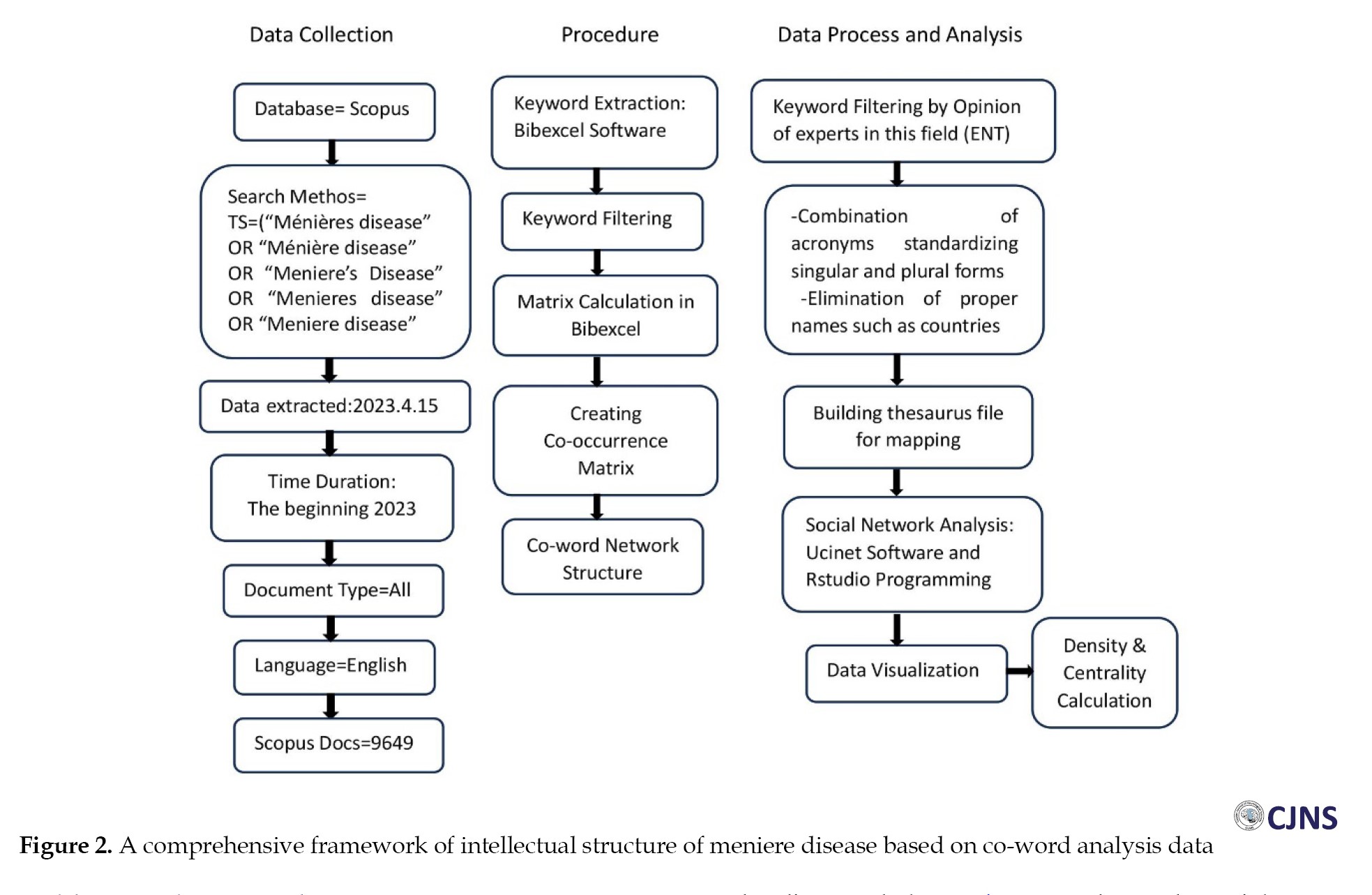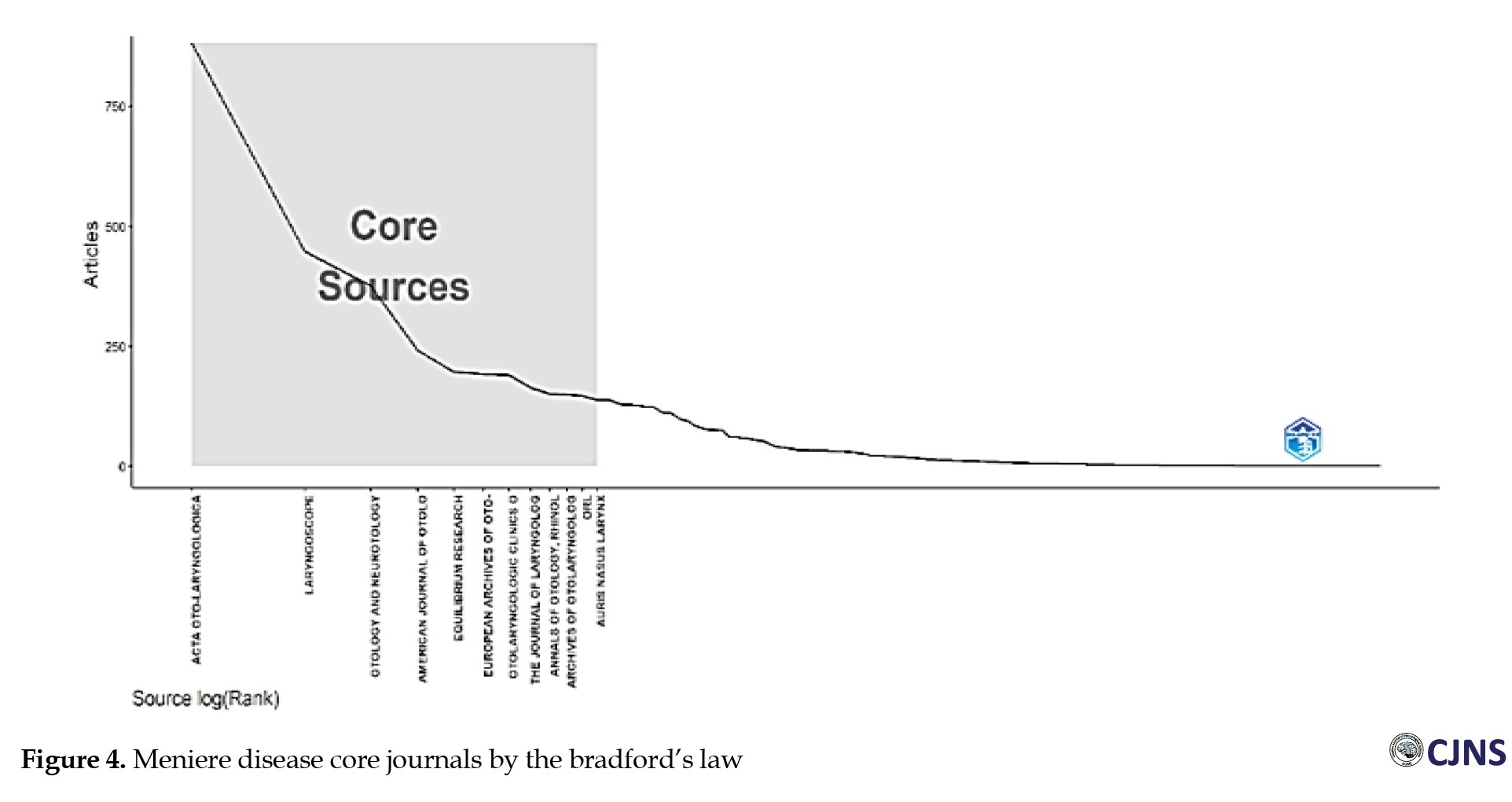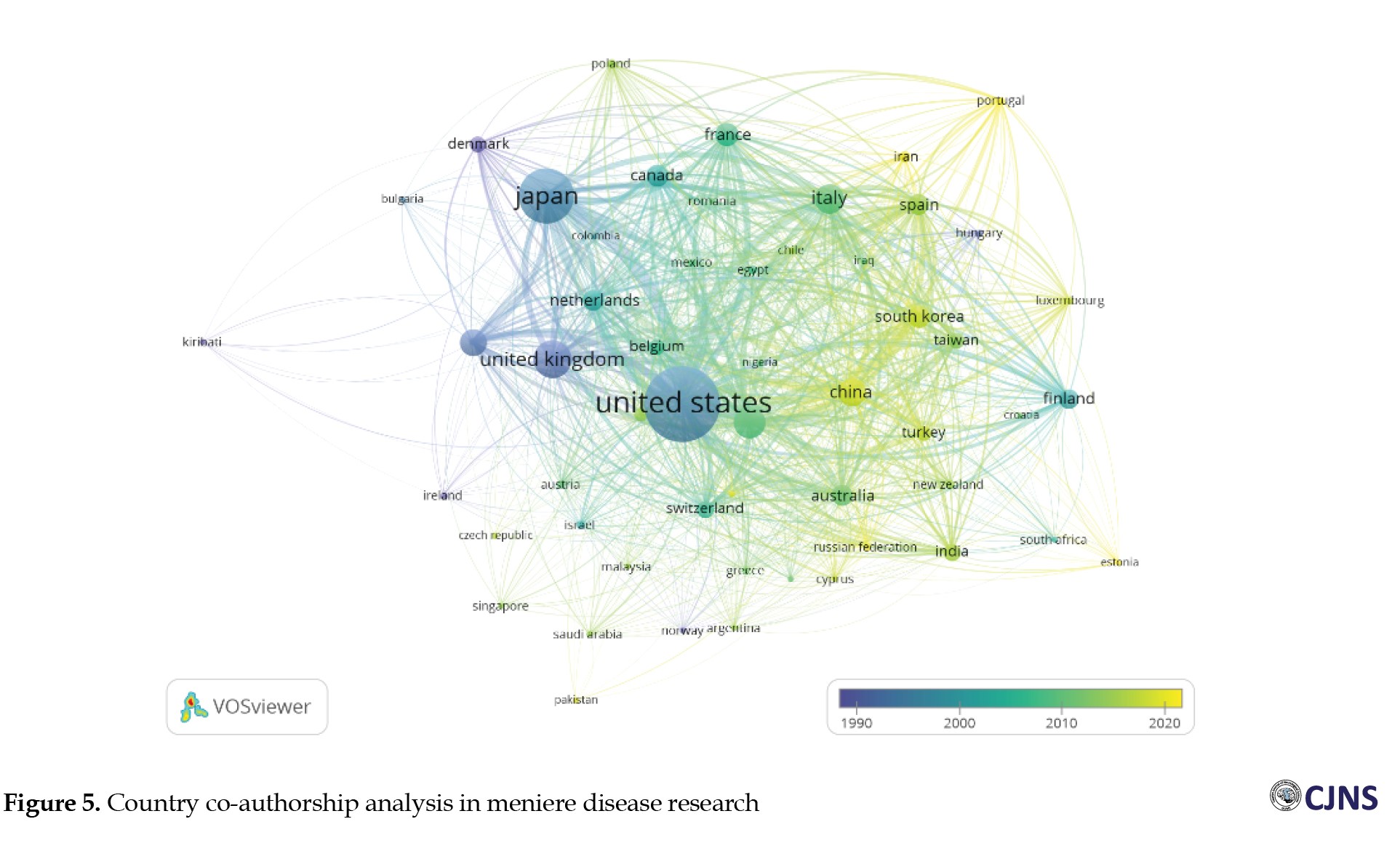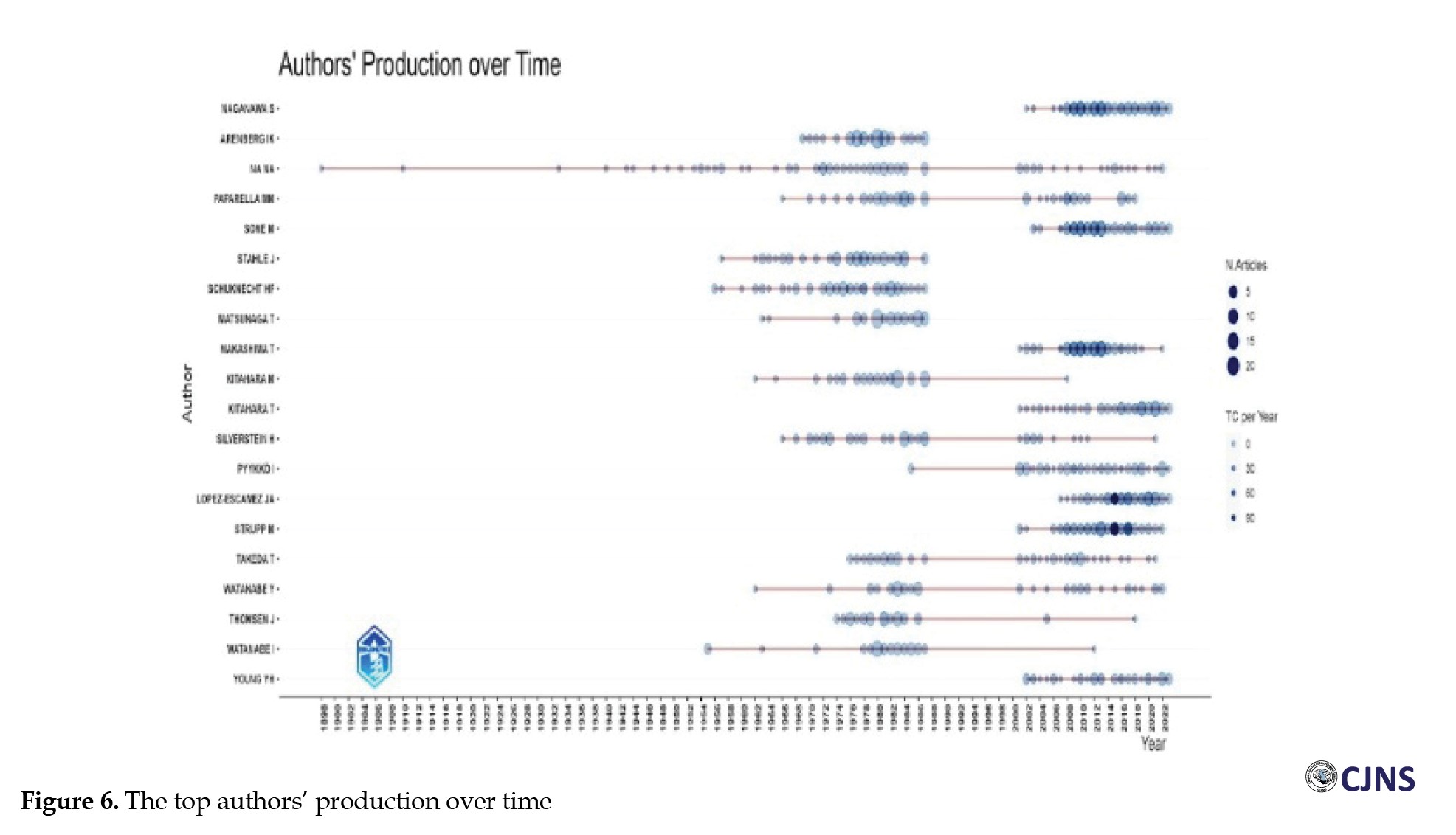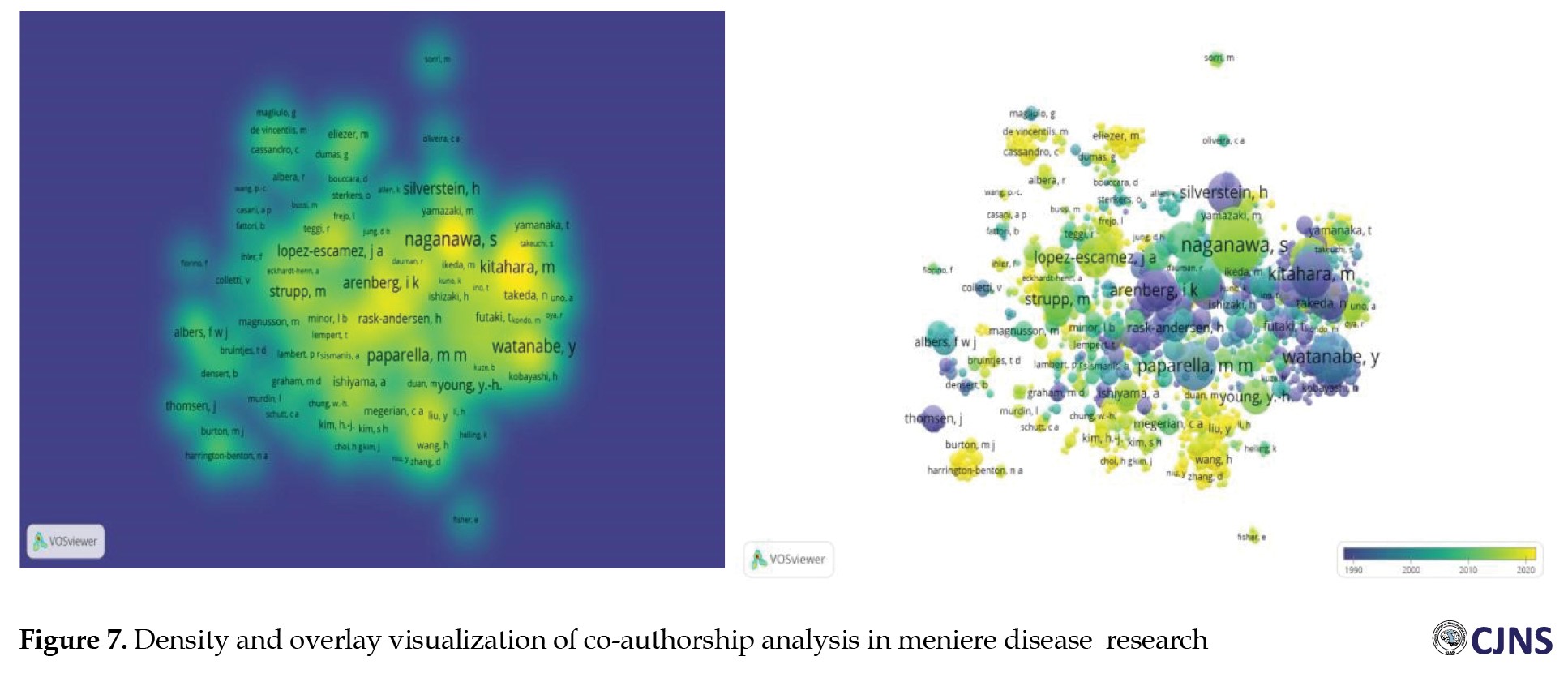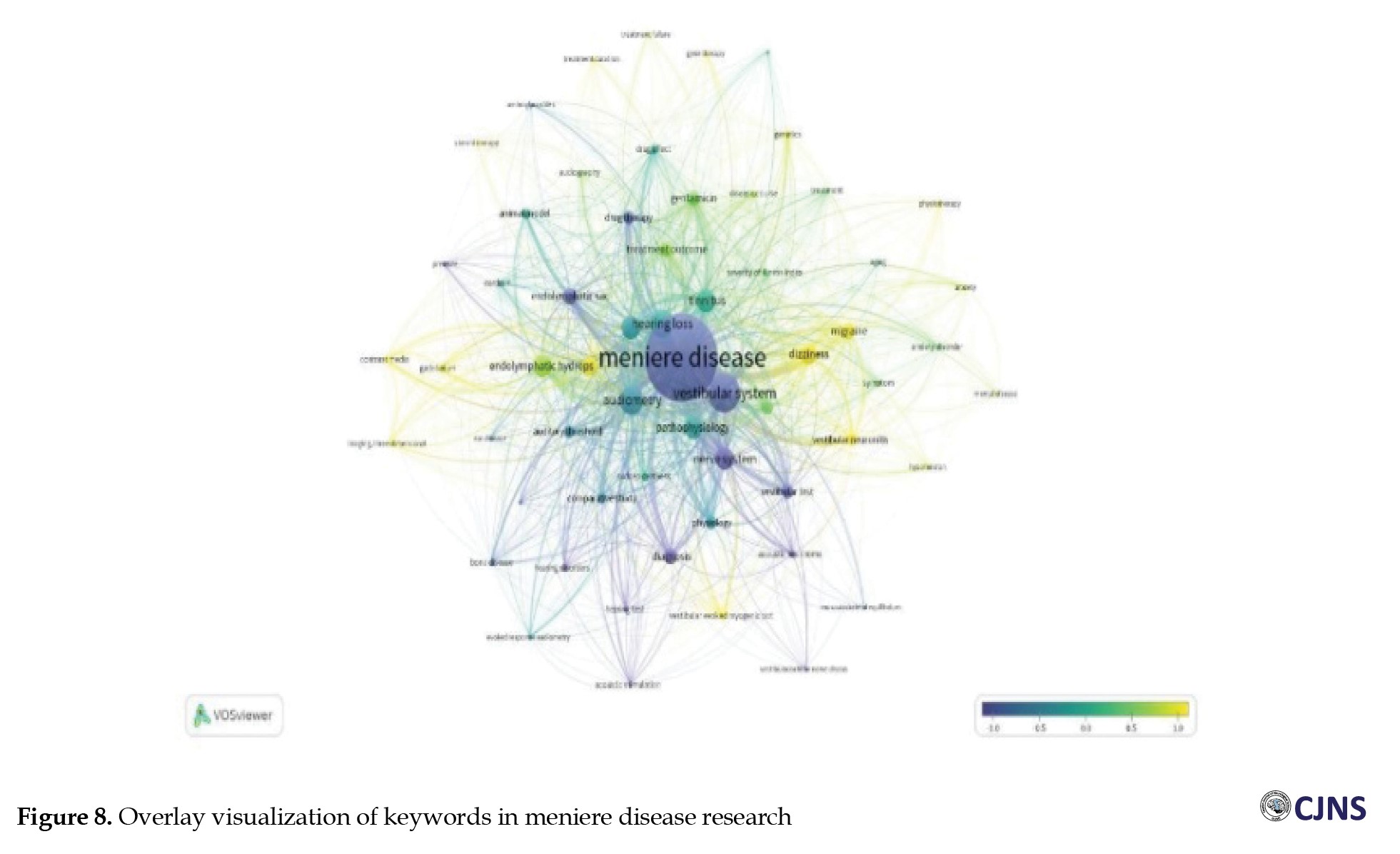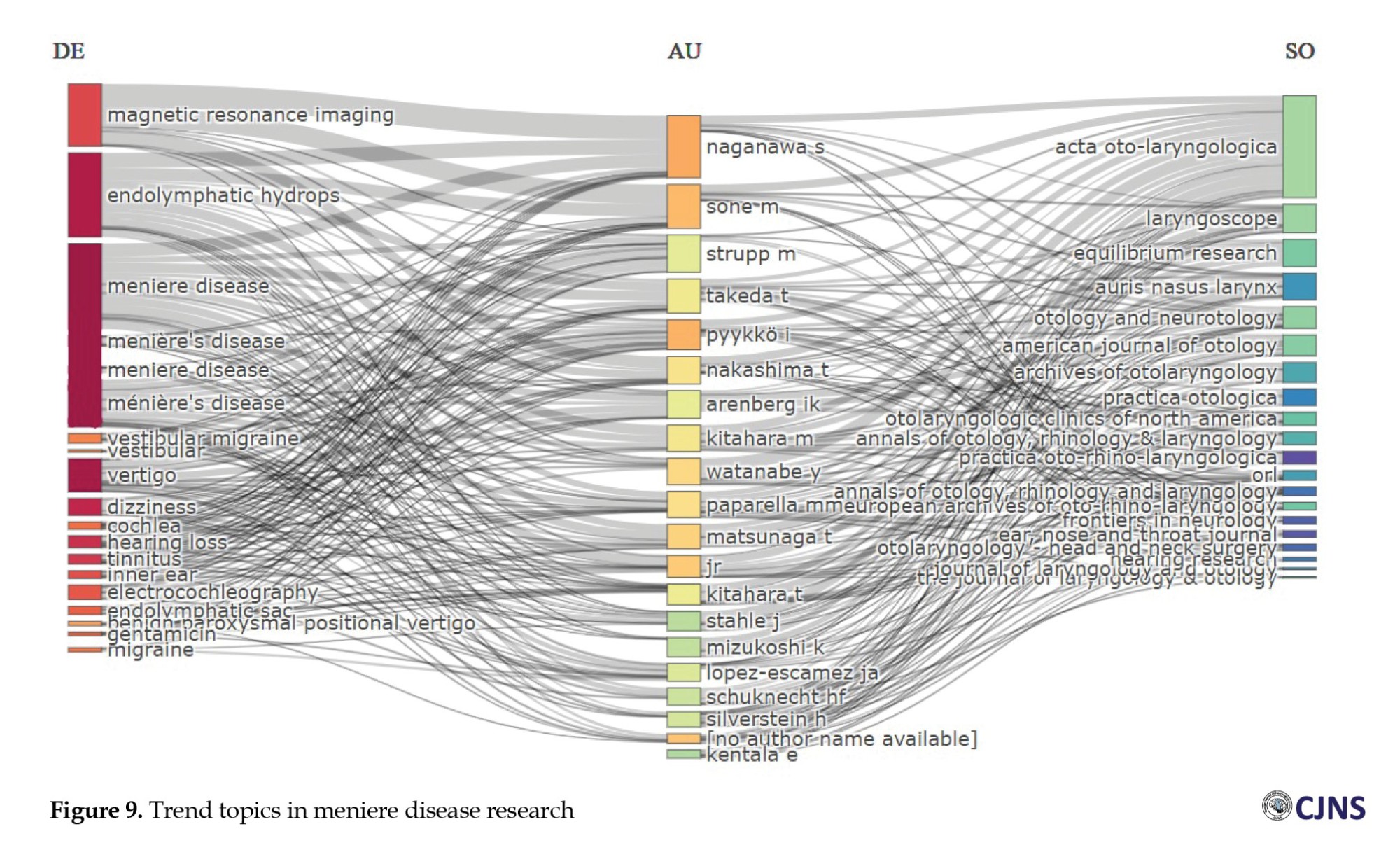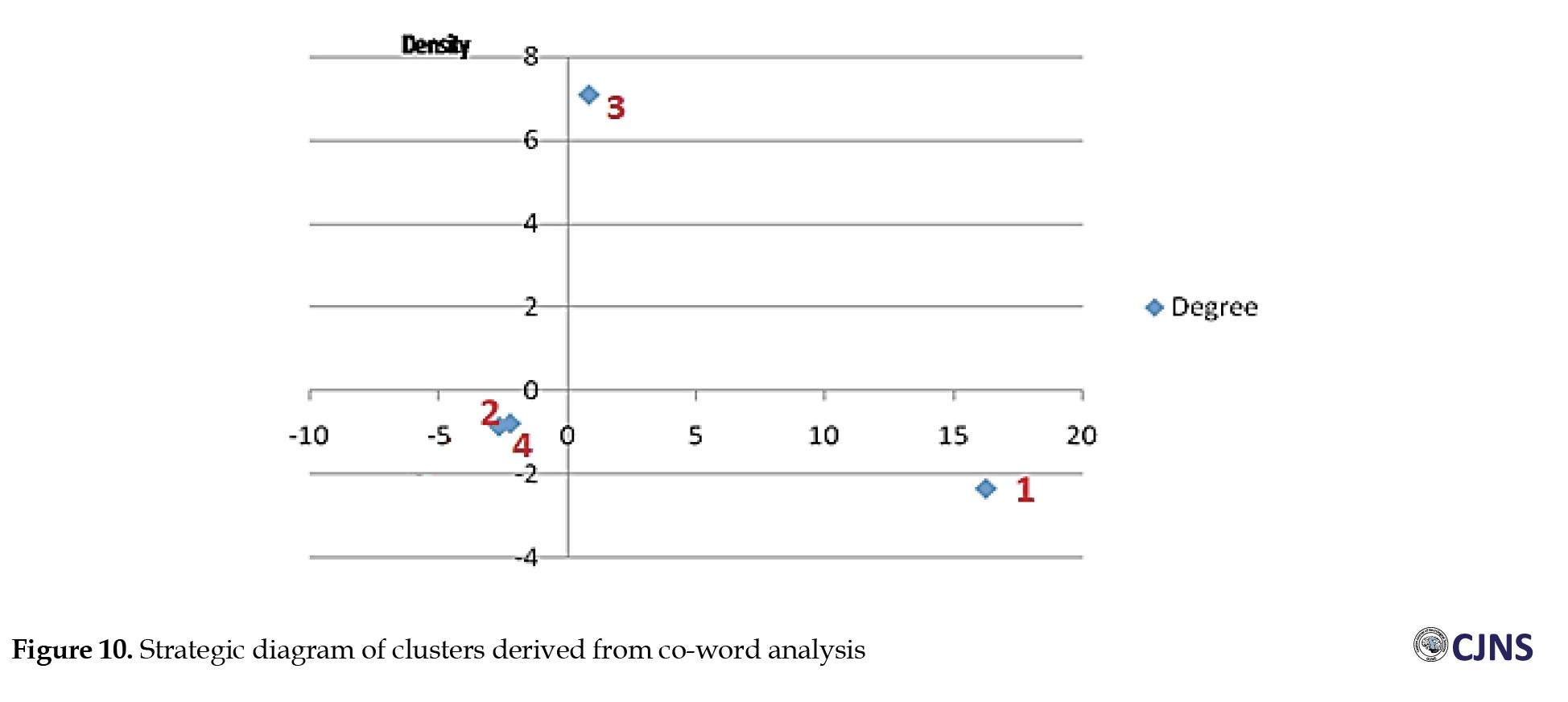Mon, Sep 29, 2025
Volume 11, Issue 1 (Winter 2025)
Caspian J Neurol Sci 2025, 11(1): 1-16 |
Back to browse issues page
Ethics code: --
Download citation:
BibTeX | RIS | EndNote | Medlars | ProCite | Reference Manager | RefWorks
Send citation to:



BibTeX | RIS | EndNote | Medlars | ProCite | Reference Manager | RefWorks
Send citation to:
Nemati S, Sarli S, Ghorbani Bousari R. Tracing the Landscape of Research in Meniere Disease: A Visualized Analysis. Caspian J Neurol Sci 2025; 11 (1) :1-16
URL: http://cjns.gums.ac.ir/article-1-733-en.html
URL: http://cjns.gums.ac.ir/article-1-733-en.html
1- Department of Otolaryngology and Head and Neck Surgery, Otorhinolaryngology Research Center, School of Medicine, Guilan University of Medical Sciences, Rasht, Iran. , nemati@gums.ac.ir
2- Department of Otolaryngology and Head and Neck Surgery, School of Medicine, Guilan University of Medical Sciences, Rasht, Iran.
3- Department of Knowledge and Information Science, School of Pharmacy, Guilan University of Medical Sciences, Rasht, Iran.
2- Department of Otolaryngology and Head and Neck Surgery, School of Medicine, Guilan University of Medical Sciences, Rasht, Iran.
3- Department of Knowledge and Information Science, School of Pharmacy, Guilan University of Medical Sciences, Rasht, Iran.
Full-Text [PDF 4416 kb]
(365 Downloads)
| Abstract (HTML) (674 Views)
Full-Text: (298 Views)
Introduction
One of the most common disorders in otolaryngology, audiology, and neuro-otology is Meniere disease (MD), first reported by Meniere Prosper in 1861. MD causes intermittent true vertigo, sensorineural hearing loss, tinnitus and ear fullness. Endolymphatic hydrops are the proposed fundamental pathological basis, but their exact etiology and pathogenesis are unknown. However, many theories, such as autoimmunity, autoimmunity, psychological stress, viral infection, anatomical variables, trauma and genetic factors [1], have been suggested. It is often treated with medication and changes in lifestyle, but other interventions are sometimes used [2].
From its first description till recent years, our knowledge about different aspects of MD has improved and changed significantly. Bibliometric methods that analyze publications are commonly used to qualify and track the progress of science and technology, including emerging topics [3]. It is necessary to use bibliometric analysis to understand the research process and the features of the knowledge structure of different research areas [4].
Co-word analysis can give a comprehensive picture of the topics covered in the literature. The frequency of word occurrence is a primary metric in content analysis. This measure analyzes frequently occurring terms to investigate primary topics within a field. The frequency of a specific term is a measure of its significance and concept. Keywords can effectively determine the content of a paper. When two terms appear together in a publication, they are semantically related. Keywords that co-occur more often are more correlated [5]. According to Callon et al. [6], co-word analysis identifies and visualizes keyword interactions [7] and can be used to identify a new domain and the relations between domains in knowledge structure quantitatively [8]. In other words, researchers employ it to investigate conceptual work in different domains [9].
To extract the essential terms of MD, co-word analysis with social network analysis (SNA) techniques has been chosen using the clustering method (hierarchical clustering) and strategic diagram in this paper.
A co-word analysis generates a strategy diagram that visually represents the themes of the current study, emerging themes, and prospective patterns for future research. Consequently, the results offer a framework for further investigation in this research [10]. The strategic diagram has been constructed using the centrality and density of each cluster [6]. Density reflects the cohesion of a cluster and serves as an indicator of a theme’s evolution over time. Centrality refers to the strength of connections between the research theme and others, representing its importance in community development. The y-axis shows a cluster’s internal coherence (density), while the x-axis shows the degree of interaction between nodes (centrality) [11].
Because of its high density and strong centrality, the upper-right quadrant is referred to as the motor theme. These themes are well developed and are essential to a research study’s structure. Upper-left quadrant themes are peripheral and specialized. These themes marginalize the research since they have strong internal ties but unimportant external ones. Weakly developed and marginal themes in the lower left quadrant may emerge or disappear. Low density and centrality characterize these themes. They have shown little research interest. Lower right quadrant themes are general, transversal, and essential. These themes are crucial to the research but have not been developed well [10].
When using hierarchical clustering, it is possible to establish and visualize the relationships between different groups of keywords. Hierarchical clustering was carried out in SPSS, and the VOSviewer program was used to show each cluster. Hence, a multi-dimensional map was created using UCINET. Analyzing the co-word matrix network, such as centrality and density, can help researchers better understand the dominant co-word structure in their study area. The concept of centrality is used to assess the degree of correlation between various topics. Nodes with a higher density are more cohesive. A research density reflects its potential to maintain or improve itself. To summarize, the study research would be more developed or prospective if it has a greater density than a higher centrality [12].
As a result, co-word analysis is used to identify clusters of keywords that frequently co-occur in publications (called themes). The density and centrality of each topic are determined and then mapped to a strategic diagram (Figure 1) to identify in which of the four major stages a theme may be found. Quadrant 1 includes motor themes that are central and developed. Quadrant 2 contains developed but isolated themes. In other words, these themes are peripheral and developed. There are emerging or declining themes in quadrant 3, which is underdeveloped and peripheral. In the fourth quadrant, there are central but undeveloped themes [11].
In addition to co-word analysis, co-authorship analysis is applied to visualize the intellectual structure of MD research. Collaboration among scientists is the social interaction between two or more individuals that facilitates exchanging ideas and completing tasks toward a common objective. Discoveries, scientific specialization, and infrastructure complexity significantly motivate collaboration and the need to combine various knowledge and skills to address complicated medical and health issues. By providing access to different disciplines, collaboration can also promote innovation and broaden the scope of a research project [13]. In the 20th century, scientific collaboration became more common across research areas. Researchers work together to advance their understanding of topics rather than working alone. Therefore, bibliometric methods measure scientific collaboration, with co-authorship being a reliable analysis method [14].
The main contributions of this paper are as follows:
1. Regarding methodology, this is the first paper to analyze co-authorship and co-word networks in MD research using scientometric indicators based on retrieved documents from the Scopus database. Additionally, SNA is applied to illustrate the intellectual structure of MD research.
2. Regarding the applied tool, this is the first time the hierarchical clustering strategic diagram techniques are used to explore the structure of (dis) similarity data in MD research. In addition, the BibExcel tool is used to analyze bibliographic data. Concerning analysis of social network data, UCINET Software is used to calculate centrality and density in MD research.
Research questions
This paper aims to answer the following research questions:
1) What is the publication year’s trend of MD research in the Scopus database? 2) Who are the top authors of MD research in the Scopus database? 3) What are the top journals of MD research in the Scopus database? 4) What is the status of country co-authorship in MD research? 5) What is the status of co-authorship analysis in MD research? 6) What are the most frequent keywords in MD research in the Scopus database? 7) How are prominent keyword clusters based on hierarchical cluster analysis in MD research?
Materials and Methods
Data source and literature inclusion criteria
Documents were retrieved from the Scopus database on April 15, 2023. Documents were selected by searching in title-abstract-keywords for the terms (“Ménières disease” OR “Ménière disease” OR “Meniere’s disease” OR “Menieres disease” OR “MD”). The experts’ opinions, the use of MeSH and the review of articles published in this field led to the selection of the above keywords. All documents were restricted to the English Language. No time limitation was applied to the documents. The retrieved documents were downloaded as a file in the RIS format. Final records were analyzed using social network analysis's (SNA's) software and RStudio software, version 2023.06.1. About 9649 documents met the study’s inclusion criteria and were included in the analysis. Then, co-word, co-authorship and SNA were employed to create a platform for visualizing the MD research network (Figure 2). Regarding co-word analysis, 850 keywords were selected from the 1001 keywords extracted by BibExcel software, version 2016.02.20.
All keywords were extracted by using the BibExcel software. These keywords were examined and unified in a separate file. Investigations show that using a square correlation matrix in the co-word analysis will result in better and more realistic results [12]. Therefore, the inclusion threshold is specified, and the co-word matrix is prepared using BibExcel software. According to Bradford law, the number of 150 keywords that had the highest co-occurrence with a cut-off of 9 was determined as the sample size. In other words, the number of co-words in the Excel file was divided by 3 and keywords in the first third were selected. After merging the two columns and sorting them in descending order, duplicate keywords were removed, and the preferred keyword was considered for the selected keywords.
Finally, 150 keywords were selected as a sample, and a square matrix was created using the BibExcel software. It is mentioned that the co-word matrix is 150*150 (.ma2). The square matrix related to the frequency of co-word was performed and converted to a correlation matrix using UCINET software, version 6, saved in Excel format software, version 2013. Then, it was transferred to the SPSS software, version 23.0 to design a dendrogram using the Ward method to assess the status quo of research on MD research in recent years. It is mentioned that the dendrogram resulted from hierarchical cluster analysis. Using cluster analysis, we created a network map of nodes and links. The cluster was determined by examining the frequency with which the same key terms appeared in the various papers. After designing the dendrogram, the main subject for each cluster was determined. Then, a strategic diagram was used to perform a co-word analysis. For this purpose, the keywords with the highest frequency were selected from each cluster to represent that cluster. Then, a separate frequency matrix was created for each cluster. In the next step, a correlation matrix was created from this matrix using UCINET software, version 6, the degree centrality and density of each cluster were calculated, and finally, a strategic diagram for MD research was illustrated. A strategic diagram of clusters was derived from the co-word analysis to determine the clusters’ maturity level and coherence; first, to create a strategic diagram, the density and centrality of all clusters were calculated using UCINET software. Then, it was illustrated using Excel to assess each topic’s coherence and maturity. VOSviewer software, version 1.6.9 was used to generate and visualize network maps for co-occurrence keywords, journals, and countries. RStudio programming, which runs Biblioshiny, was used to illustrate authors’ production over time and the trend of publication year.
Results
The main information about MD research showed that different types of sources in MD research were accompanied by a 2.92 % annual growth rate and an average age of 9649 MD documents was 25.3. There are about 18 references for each document, and the average number of citations per doc was 16.97. The annual growth rate of MD documents is positive, but the percentage is not high (2.92%).
Publication by year
Figure 3 shows the trend of publication years in MD research while running the Biblioshiny App in RStudio programming. The trend of publication year is relatively upward, but its ups and downs are clear.
Publication by journal
Among 1192 Journals, Acta Oto-Laryngologica obtained the first rank among the Journals’ published documents concerning MD research with more productivity (879 docs). In the following rank, Laryngoscope, Otology and Neurotology published the most documents about MD (with 445 and 375 documents, respectively). One of the most important evaluation tools of journals is Bradford’s Law. Bradford’s Law of scattering claims that when a collection of scientific journals is organized by the number of articles related to a specific subject, with the most prolific journal listed first and the least productive last, the journals will be categorized into distinct zones, each producing a similar number of relevant articles. Nevertheless, the number of journals in each zone will increase quickly [15].
The diagram below (Figure 4) shows the article productivity trend over a given period.
Publication by the country
According to the map of country co-authorship, which VOSviewer visualized, 34% of the 150 countries (51 countries) had at least 5 publications. The findings indicated that the United States is the most influential country in cooperation with other countries with other countries in the production of 2386 documents that received 62280 citations. Iran has 16 documents and 204 citations compared to other countries and is placed in the 32nd rank in terms of country co-authorship analysis. According to map 1, many countries, such as South Korea, China, Iran, Turkey and Spain, marked with yellow, have played a significant role in MD research in recent years (Figure 5).
Publication by authors
Naganawa S, Sone M and Pyykkö I had more documents among MD researchers, with 113, 99 and 96 documents, respectively. According to Figure 6, Naganawa S, Sone M, Lopez-escapes JA and Strupp M. have produced more in this field in the last few years. Some authors, such as Stahle J, Schuknecht HF and Matsunaga T, produced MD documents at a certain time.
Co-authorship analysis
Bibliometric analysis included co-authorship analysis using VOSviewer and Scopus Analytics. VOSviewer supports network and overlay visualization [16]. According to the findings, 953 co-authorships in MD research were obtained from VOSviewer. Paparella MM, Nakashima T and Kitahara M. were ranked 1 to 3 with 86, 83 and 81 documents, respectively. However, Strupp M, Nakashima T and Naganawa S. received 4064, 3906, and 3870 citations in co-authorship analysis, respectively.
In the following map (Figure 7), overlay and network visualizations have the exact bibliographic mapping even though various colors represent different types of information. The overlay visualization illustrates the average yearly publication of each term, while the network visualization displays the groupings of keyword clusters [16].
Different colors indicate different types of information, but overlay and network visualizations use the exact bibliographic mapping. The overlay visualization shows each term’s average annual publication, while the network visualization shows keyword clustering [16].
Co-word analysis
Co-word analysis uses keyword co-occurrence to identify related keywords [17]. The titles, abstracts and keywords of the 9469 documents included in this study were analyzed via bibExcel,VOSviewer software and RStudio programming. Keywords “Menier’s disease,” “hearing loss” and “auditory system,” with 10160, 8205 and 5617 repetitions, have the highest frequency among the keywords, respectively. For better understanding, Overlay visualization of keywords in MD research is provided (Figure 8). However, an interview was done with neurotologists about the importance of retrieved keywords. Based on their opinion, the top keywords in accompany by MD in clinical and research practice are “hearing loss”/”deafness,” “therapy,” “tinnitus” and “magnetic resonance imaging,” respectively.
Three-filed plot
A three-plot diagram, also known as the Sankey diagram, is used to investigate the link and flow between keywords (DE), authors (AU), sources (SO), cited sources (CR_SO), countries (CO), titles (TI), abstracts (AB), keyword Plus (ID), affiliations (AU_UN) or references (CR).
A three-plot diagram, also known as the Sankey diagram has been used to investigate the link and flow between keywords, authors and sources, as shown in Figure 9. It is an effective tool for illustrating the movement of entities, where the thickness of the arrows and boxes is determined by the frequency of publications [18]. The themes in the Figure are named based on the terms that appear the most frequently [19].
MD, endolymphatic hydrops, and magnetic resonance imaging are the most frequent keywords that match the authors’ publications. Furthermore, it should be noted that Naganawa S, Sone M and Strupp M. have employed a significant number of diverse keywords when compared to their counterparts, signifying their extensive coverage of the field and published in Acta Oto-Laryngologica and Laryngoscope.
The technique of co-word analysis led to the formation of 6 thematic clusters obtained from the hierarchical clustering. According to the opinions of MD specialists, the cluster of vestibular MD (consists of 2 keywords: “vestibular disorder” and “vestibular test”) and effects of gentamicin on hearing loss” (consists of 3 keywords: “audiometry,” “gentamicin” and “hearing loss”) were put away because these clusters have no clinical use (Appendixes 1 and 2).
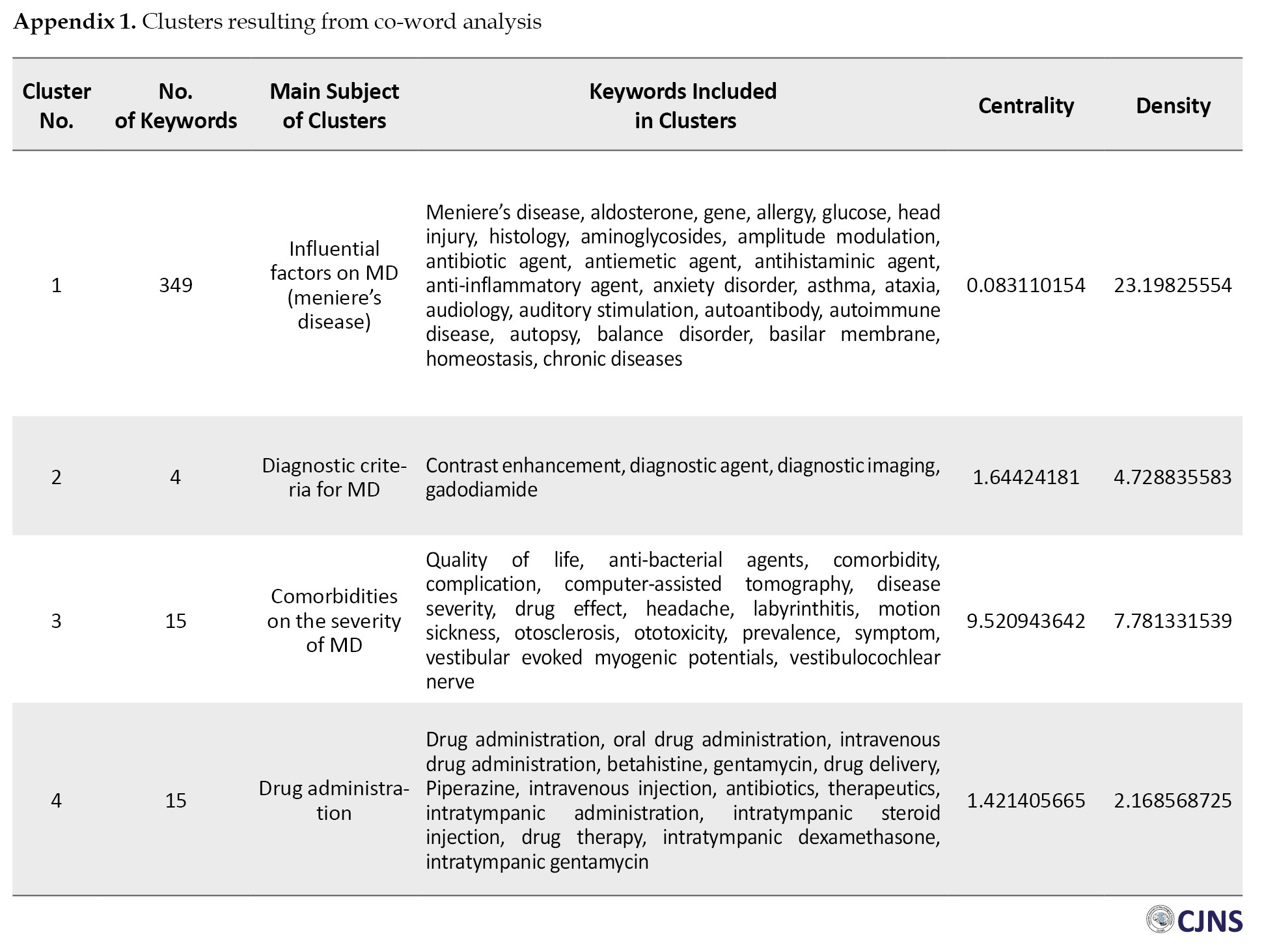
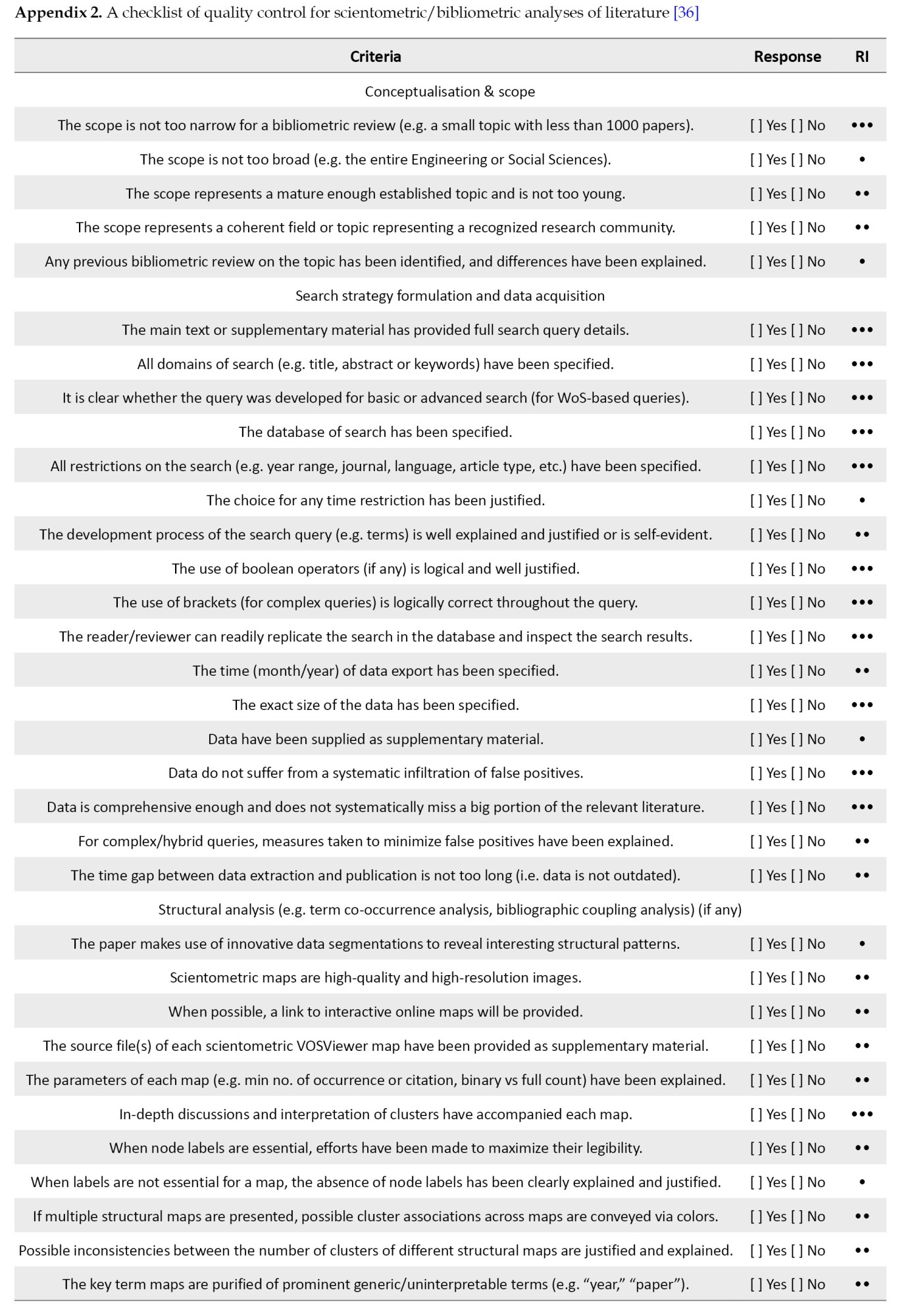
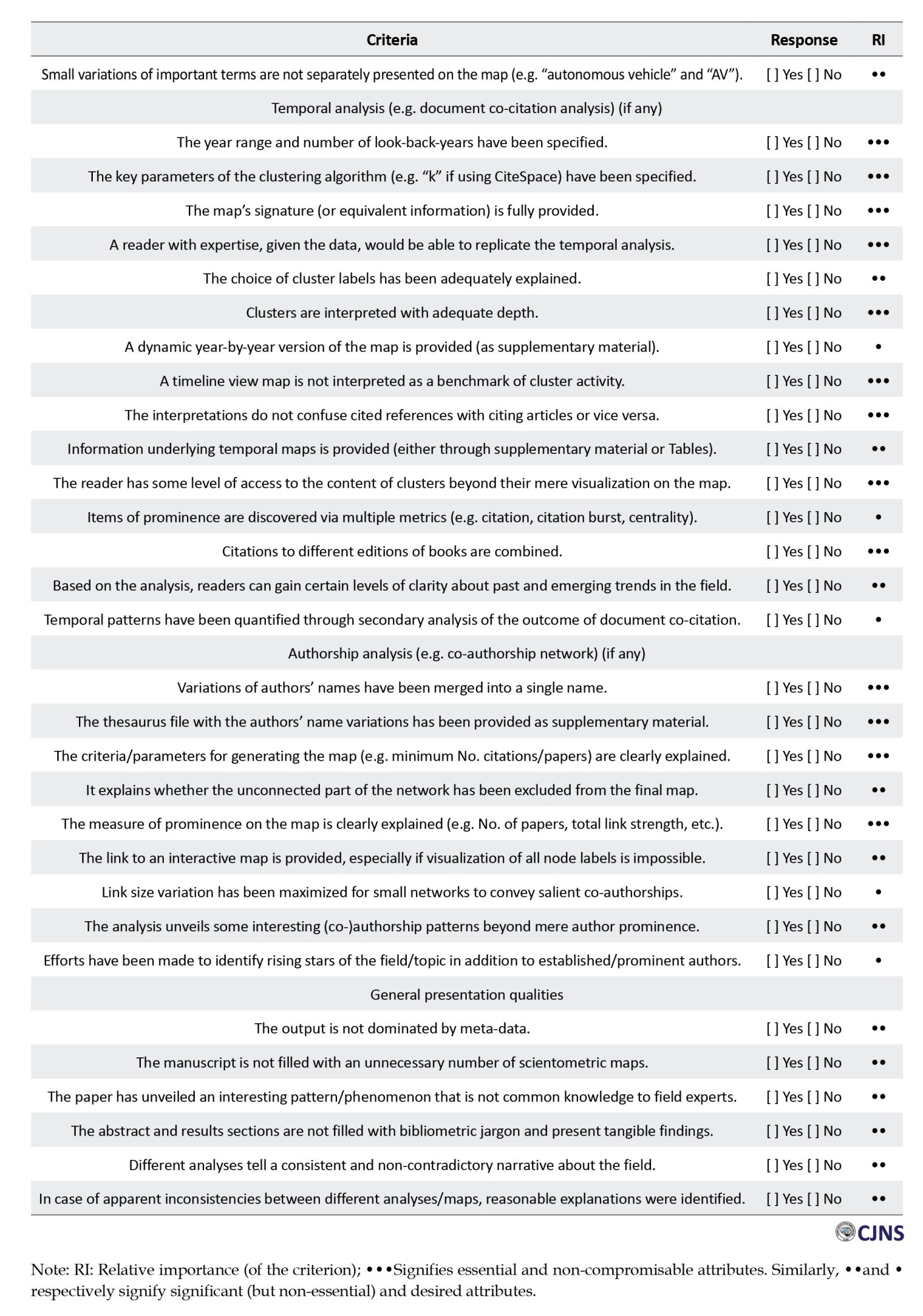
Regarding cluster 1, influential factors on MD, the co-word analysis results indicated that 349 keywords contributed to the formation of this cluster. The keywords of the cluster, such as “MD, age, gene, allergy, glucose, head injury, histology, aminoglycoside, amplitude modulation, antibiotic agent, antiemetic agent, antihistaminic agent, anti-inflammatory agent, anxiety disorder and the like, suggest that its theme be considered “influential factors on MD.”
The second cluster, diagnostic criteria for MD, consists of 4 keywords: “Contrast enhancement,” “diagnostic agent,” “diagnostic imaging” and “gadodiamide.”
Cluster 3, related to comorbidities on the severity of MD, consists of 15 keywords, such as comorbidity, complication, disease severity, headache, labyrinthitis, motion sickness, otosclerosis, prevalence, symptom, relieving symptoms, etc. that shows the theme of this cluster well.
Finally, cluster 4, drug administration for MD, consists of 16 keywords of drug administration, oral drug administration, intravenous drug administration, intratympanic drug administration, betahistine, gentamycin, drug delivery, piperazine, intravenous injection, antibiotics, therapeutics, intratympanic administration, intratympanic steroid injection, drug therapy, intratympanic dexamethasone, intratympanic gentamycin. A strategic diagram was drawn to illustrate the location of each cluster based on density and degree.
The clusters were distributed in a strategic diagram (Figure 10). The findings indicated that cluster 3 was well-developed and considered central and developed themes. Clusters 2 (diagnostic criteria for MD) and 4 (drug information for MD) were located in the third area of the diagram and considered emerging or declining themes. Cluster 1 is located in the fourth area of the diagram; it is a central cluster but not developed. It may be due to its low centrality (0.083110154). According to Figure 10, cluster 1 (Influential factors on MD) has the highest density with a value of 23.19825554 and cluster 3 (related comorbidities on the severity of MD) has the highest centrality with a value of 9.520943642. It means that cluster 3 has the highest occurrence of keywords and holds the most significant position in terms of impact. Cluster 3 shows a high degree of density and centrality. The themes of MD research rely on these well-developed themes.
Discussion
MD is a medical condition affecting the inner ear that is identified by symptoms, including episodic vertigo, aural fullness or aural pressure, tinnitus and low-frequency hearing loss [2]. MD is often misdiagnosed because endolymphatic hydrops and defects are difficult to detect directly using additional testing equipment. MD literature has grown in recent years [20]. Therefore, it is essential to investigate the research status in this field. Interestingly, only two studies [20, 21] utilized a bibliometric and visualization study to analyze the research progress of MD in the WoS database. Hence, this is the only study to analyze the existing scientific literature about MD research from the beginning to 2023, including 9649 articles retrieved from the Scopus database. Then, co-word analysis, co-authorship analysis and SNA will address the research questions. Although the number of MD papers has increased significantly in recent years, this growth can be attributed to experimental techniques, research investment and advances in assistive technology and clinical treatments in MD research. Concerning the countries, although Iran is ranked 32nd among countries, it is considered an emerging country in recent years. According to the results, Asian countries such as Iran, China and Turkey have emerged in the production of this field. Developing countries should strengthen their cooperation with developed countries (United States and European countries) to advance MD research, which benefits patients.
However, according to [20], the most notable MD researchers are from advanced countries like the US, Europe and Japan. As a result, encouraging communication and collaboration among researchers worldwide will aid in advancing MD research. Utilizing a co-authorship network allows us to observe the partnerships among researchers in a particular field and visually discern the distinct research areas within that [21].
To learn about the hot topics of other databases regarding MD and discuss them with the comparative results, a separate search was conducted in PubMed and Web of Science databases. For this purpose, 3055 documents were extracted from PubMed using topic search (TS) format and analyzed using RStudio. The results indicated that treatment outcome, diagnosis, vestibular test, magnetic resonance imaging surgery, physiopathology, drug therapy and vertigo/etiology are the most important keywords of MD. Also, a TS was conducted on the Web of Science. As a result, 5846 documents were retrieved and analyzed by RStudio. The results showed that the most frequent keywords are endolymphatic hydrops, vertigo, symptoms, therapy, prevalence, dizziness and sensorineural hearing loss. One area of research into MD is focusing on understanding the underlying causes of the disease. Most research on MD focuses on its epidemiology, pathophysiology and treatment and top keywords suggest new and emerging trends in this scientific research [20, 22]. Despite the unknown cause, researchers speculate that genetic, environmental, and anatomical factors could play a role in its development [23]. Various factors, including autoimmune disorders, viral infections, and imbalances in inner ear fluid, can pose risks [24]. The research also looks into the diagnosis and monitoring of MD, as these are appealing areas of study. Currently, diagnosis [25].
Advanced imaging techniques, like magnetic resonance imaging, can reveal structural abnormalities in the inner ear that may be related to MD [26]. Although this condition has no cure, treatments are available to alleviate symptoms and improve quality of life. These treatments include lifestyle adjustments, medication, and surgical interventions, which are known as the treatments for MD [27]. New approaches, such as intra-tympanic injections and vestibular rehabilitation therapy, aim to enhance balance and reduce dizziness through specific exercises [28]. Dietary changes, complementary therapies, and new medications are also utilized to manage MD symptoms [2].
According to the results of Hallpike and Cairns [29], neurologists and otolaryngologists have faced considerable difficulty in treating MD for a considerable period. Diuretics, betahistine, intratympanic steroids, endolymphatic sac surgery, intratympanic gentamicin, and other surgical techniques are the principal treatments for MD. Therefore, correct drug administration can help MD patients to some extent. For example, dexamethasone and gentamicin impact hearing preservation in patients undergoing chemical labyrinthectomy for MD. Sensorineural hearing loss that fluctuates with aural pressure, tinnitus, and episodic vertigo is a clinical feature of MD [30]. Neuro-otology disorders such as vertigo, tinnitus, and hearing loss might be the clue to impending concomitant MD [31].
On the other hand, stress, sleep deprivation, some foods, allergies, barometric pressure change and hormonal changes may cause MD attacks [32], allergies, and autoimmune system implicate in MD [33]. Among other influential factors for MD, age and sleep disorders are regarded as risk factors, while hypothyroidism, sex, and genes are tentative risk factors [34]. It can impact the patient’s quality of life significantly, and research is underway to understand better the disease causes and mechanisms [35]. Vestibular rehabilitation therapy can immediately improve the quality of life in patients with MD [36]. The result of Orji. [37] showed that patients with more severe vertigo symptoms tend to experience a worse quality of life. Another study by Yardley et al. [38] also emphasizes the importance of quality of life in MD. Patients with MD who experience more severe vertigo symptoms often report a worse quality of life. Also, it is observed in [39] that MD group has higher rates of allergic rhinitis and asthma, lower systolic blood pressure, high-density lipoprotein, cholesterol and gamma-glutamyltrans-peptidase (rGT) and less alcohol and smoking [39]. Scarpa et al. [40] found that intravenous glycerol infusion can improve vertigo attacks and reduce tinnitus-related discomfort, ultimately enhancing the quality of life for MD patients. Also, the psychological and social aspects of the disease are investigated in MD research [37].
The results of this study can provide valuable insights for researchers, especially researchers of Otolaryngology and Head and Neck Surgery, to identify more specific research focus within the MD field and find top authors to expand their international collaborations. The study also highlights the importance of SNA and scientometric indicators in understanding the intellectual structure of MD research. By tracing the landscape of research in the MD field, the researchers can acquire an in-depth knowledge of the current state of research, identify gaps in knowledge, and develop new research directions. Overall, this study enhances the existing literature on MD research and serves as a valuable resource for scholars in this domain.
Conclusion
The results indicate that different types of sources in MD research are accompanied by a 2.92% annual growth rate, and the average age of MD documents is 25.3. The annual growth rate of MD documents is positive, but the percentage is not high (2.92%). Concerning authors’ collaboration, the results showed that the number of single-authored docs is over 6 times that of co-authors per docs. Core journals retrieved from Bradford’s Law indicated that Acta Oto-Laryngologica, Laryngoscope, Otology and Neurotology are the top three journals that publish MD research. Analysis of country co-authorship showed that the United States accounted for 25% of the articles on MD and its productions (2386) received 62280 citations. Regarding the top authors in this field, Naganawa S. had more documents among MD researchers. He is from Japan with an H-index of 54 (502 docs and 12346 citations), and his most contributed topics during 2018-2022 are endolymphatic hydrops, MD, and magnetic resonance imaging in the Scopus database.
In terms of co-authorship analysis, Paparella M and Strupp M were the most influential researchers, with the highest productivity and efficiency. It is worth noting that Paparella M and Nakashima had more documents, and Strupp M and Nakashima T had more citations based on co-authorship analysis, respectively, based on co-authorship analysis. Regarding co-word analysis, top MD research topics were MD, hearing loss, auditory system, and vestibular disorder, which had the highest frequency among other topics in this field.
According to the frequency of keywords, most research on MD focuses on its epidemiology, pathophysiology, and treatment and top keywords suggest that there are new and emerging trends in this scientific research.
The application of co-word analysis led to the formation of 6 clusters. It was found that the cluster of “related comorbidities on the severity of MD” may become a research hotspot, well developed and hold the most significant impact. The other clusters are called «influential factors on MD,” “diagnostic criteria for MD” and «drug administration for MD.” Notably, two clusters of «diagnostic criteria for MD» and «drug administration for MD» considered emerging or declining themes. Also, the “influential factors on MD” cluster was a central cluster but not developed. The results of the Sankey diagram indicated that MD, endolymphatic hydrops, and magnetic resonance imaging are the most frequent keywords matching the authors’ publications. Furthermore, it is worth noting that Naganawa. S, Sone M, and Strupp M. used a significant number of diverse keywords when compared to their counterparts, indicating broad domain coverage and published in Acta Oto-Laryngologica and Laryngoscope.
Suggestions for future research
Researchers can consider other bibliometric techniques (i.e. author co-citation analysis, document co-citation analysis, etc.) to survey the intellectual structure of the research. Regarding nationality, affiliation, etc. the nature of researchers can be examined and used to complete the research results. Based on the thematic clusters obtained from the co-word analysis, separate research will be conducted to examine the knowledge structure of each cluster.
Data availability statement
The study’s original contributions are included in the article and supplemental materials. For additional information, please contact the corresponding author.
Ethical Considerations
Compliance with ethical guidelines
The study followed the applicable guidelines and declaration.
Funding
This research did not receive any grant from funding agencies in the public, commercial, or non-profit sectors.
Authors contributions
Data collection, validation, conceptualization, visualization and investigation: Shadman Nemati and Roghayeh Ghorbani Bousari; Supervision and project administration: Shadman Nemati; Methodology and formal analysis: Roghayeh Ghorbani Bousari; Resources: Sina Sarli; Review and editing: Shadman Nemati and Sina Sarli; Final approval: All authors.
Conflict of interest
The authors declared no conflict of interest.
Acknowledgements
The authors thank all Otolaryngology, Head and Neck Surgery Research Centre members at Guilan University of Medical Sciences, Rasht, Iran, for their support.
References
One of the most common disorders in otolaryngology, audiology, and neuro-otology is Meniere disease (MD), first reported by Meniere Prosper in 1861. MD causes intermittent true vertigo, sensorineural hearing loss, tinnitus and ear fullness. Endolymphatic hydrops are the proposed fundamental pathological basis, but their exact etiology and pathogenesis are unknown. However, many theories, such as autoimmunity, autoimmunity, psychological stress, viral infection, anatomical variables, trauma and genetic factors [1], have been suggested. It is often treated with medication and changes in lifestyle, but other interventions are sometimes used [2].
From its first description till recent years, our knowledge about different aspects of MD has improved and changed significantly. Bibliometric methods that analyze publications are commonly used to qualify and track the progress of science and technology, including emerging topics [3]. It is necessary to use bibliometric analysis to understand the research process and the features of the knowledge structure of different research areas [4].
Co-word analysis can give a comprehensive picture of the topics covered in the literature. The frequency of word occurrence is a primary metric in content analysis. This measure analyzes frequently occurring terms to investigate primary topics within a field. The frequency of a specific term is a measure of its significance and concept. Keywords can effectively determine the content of a paper. When two terms appear together in a publication, they are semantically related. Keywords that co-occur more often are more correlated [5]. According to Callon et al. [6], co-word analysis identifies and visualizes keyword interactions [7] and can be used to identify a new domain and the relations between domains in knowledge structure quantitatively [8]. In other words, researchers employ it to investigate conceptual work in different domains [9].
To extract the essential terms of MD, co-word analysis with social network analysis (SNA) techniques has been chosen using the clustering method (hierarchical clustering) and strategic diagram in this paper.
A co-word analysis generates a strategy diagram that visually represents the themes of the current study, emerging themes, and prospective patterns for future research. Consequently, the results offer a framework for further investigation in this research [10]. The strategic diagram has been constructed using the centrality and density of each cluster [6]. Density reflects the cohesion of a cluster and serves as an indicator of a theme’s evolution over time. Centrality refers to the strength of connections between the research theme and others, representing its importance in community development. The y-axis shows a cluster’s internal coherence (density), while the x-axis shows the degree of interaction between nodes (centrality) [11].
Because of its high density and strong centrality, the upper-right quadrant is referred to as the motor theme. These themes are well developed and are essential to a research study’s structure. Upper-left quadrant themes are peripheral and specialized. These themes marginalize the research since they have strong internal ties but unimportant external ones. Weakly developed and marginal themes in the lower left quadrant may emerge or disappear. Low density and centrality characterize these themes. They have shown little research interest. Lower right quadrant themes are general, transversal, and essential. These themes are crucial to the research but have not been developed well [10].
When using hierarchical clustering, it is possible to establish and visualize the relationships between different groups of keywords. Hierarchical clustering was carried out in SPSS, and the VOSviewer program was used to show each cluster. Hence, a multi-dimensional map was created using UCINET. Analyzing the co-word matrix network, such as centrality and density, can help researchers better understand the dominant co-word structure in their study area. The concept of centrality is used to assess the degree of correlation between various topics. Nodes with a higher density are more cohesive. A research density reflects its potential to maintain or improve itself. To summarize, the study research would be more developed or prospective if it has a greater density than a higher centrality [12].
As a result, co-word analysis is used to identify clusters of keywords that frequently co-occur in publications (called themes). The density and centrality of each topic are determined and then mapped to a strategic diagram (Figure 1) to identify in which of the four major stages a theme may be found. Quadrant 1 includes motor themes that are central and developed. Quadrant 2 contains developed but isolated themes. In other words, these themes are peripheral and developed. There are emerging or declining themes in quadrant 3, which is underdeveloped and peripheral. In the fourth quadrant, there are central but undeveloped themes [11].
In addition to co-word analysis, co-authorship analysis is applied to visualize the intellectual structure of MD research. Collaboration among scientists is the social interaction between two or more individuals that facilitates exchanging ideas and completing tasks toward a common objective. Discoveries, scientific specialization, and infrastructure complexity significantly motivate collaboration and the need to combine various knowledge and skills to address complicated medical and health issues. By providing access to different disciplines, collaboration can also promote innovation and broaden the scope of a research project [13]. In the 20th century, scientific collaboration became more common across research areas. Researchers work together to advance their understanding of topics rather than working alone. Therefore, bibliometric methods measure scientific collaboration, with co-authorship being a reliable analysis method [14].
The main contributions of this paper are as follows:
1. Regarding methodology, this is the first paper to analyze co-authorship and co-word networks in MD research using scientometric indicators based on retrieved documents from the Scopus database. Additionally, SNA is applied to illustrate the intellectual structure of MD research.
2. Regarding the applied tool, this is the first time the hierarchical clustering strategic diagram techniques are used to explore the structure of (dis) similarity data in MD research. In addition, the BibExcel tool is used to analyze bibliographic data. Concerning analysis of social network data, UCINET Software is used to calculate centrality and density in MD research.
Research questions
This paper aims to answer the following research questions:
1) What is the publication year’s trend of MD research in the Scopus database? 2) Who are the top authors of MD research in the Scopus database? 3) What are the top journals of MD research in the Scopus database? 4) What is the status of country co-authorship in MD research? 5) What is the status of co-authorship analysis in MD research? 6) What are the most frequent keywords in MD research in the Scopus database? 7) How are prominent keyword clusters based on hierarchical cluster analysis in MD research?
Materials and Methods
Data source and literature inclusion criteria
Documents were retrieved from the Scopus database on April 15, 2023. Documents were selected by searching in title-abstract-keywords for the terms (“Ménières disease” OR “Ménière disease” OR “Meniere’s disease” OR “Menieres disease” OR “MD”). The experts’ opinions, the use of MeSH and the review of articles published in this field led to the selection of the above keywords. All documents were restricted to the English Language. No time limitation was applied to the documents. The retrieved documents were downloaded as a file in the RIS format. Final records were analyzed using social network analysis's (SNA's) software and RStudio software, version 2023.06.1. About 9649 documents met the study’s inclusion criteria and were included in the analysis. Then, co-word, co-authorship and SNA were employed to create a platform for visualizing the MD research network (Figure 2). Regarding co-word analysis, 850 keywords were selected from the 1001 keywords extracted by BibExcel software, version 2016.02.20.
All keywords were extracted by using the BibExcel software. These keywords were examined and unified in a separate file. Investigations show that using a square correlation matrix in the co-word analysis will result in better and more realistic results [12]. Therefore, the inclusion threshold is specified, and the co-word matrix is prepared using BibExcel software. According to Bradford law, the number of 150 keywords that had the highest co-occurrence with a cut-off of 9 was determined as the sample size. In other words, the number of co-words in the Excel file was divided by 3 and keywords in the first third were selected. After merging the two columns and sorting them in descending order, duplicate keywords were removed, and the preferred keyword was considered for the selected keywords.
Finally, 150 keywords were selected as a sample, and a square matrix was created using the BibExcel software. It is mentioned that the co-word matrix is 150*150 (.ma2). The square matrix related to the frequency of co-word was performed and converted to a correlation matrix using UCINET software, version 6, saved in Excel format software, version 2013. Then, it was transferred to the SPSS software, version 23.0 to design a dendrogram using the Ward method to assess the status quo of research on MD research in recent years. It is mentioned that the dendrogram resulted from hierarchical cluster analysis. Using cluster analysis, we created a network map of nodes and links. The cluster was determined by examining the frequency with which the same key terms appeared in the various papers. After designing the dendrogram, the main subject for each cluster was determined. Then, a strategic diagram was used to perform a co-word analysis. For this purpose, the keywords with the highest frequency were selected from each cluster to represent that cluster. Then, a separate frequency matrix was created for each cluster. In the next step, a correlation matrix was created from this matrix using UCINET software, version 6, the degree centrality and density of each cluster were calculated, and finally, a strategic diagram for MD research was illustrated. A strategic diagram of clusters was derived from the co-word analysis to determine the clusters’ maturity level and coherence; first, to create a strategic diagram, the density and centrality of all clusters were calculated using UCINET software. Then, it was illustrated using Excel to assess each topic’s coherence and maturity. VOSviewer software, version 1.6.9 was used to generate and visualize network maps for co-occurrence keywords, journals, and countries. RStudio programming, which runs Biblioshiny, was used to illustrate authors’ production over time and the trend of publication year.
Results
The main information about MD research showed that different types of sources in MD research were accompanied by a 2.92 % annual growth rate and an average age of 9649 MD documents was 25.3. There are about 18 references for each document, and the average number of citations per doc was 16.97. The annual growth rate of MD documents is positive, but the percentage is not high (2.92%).
Publication by year
Figure 3 shows the trend of publication years in MD research while running the Biblioshiny App in RStudio programming. The trend of publication year is relatively upward, but its ups and downs are clear.
Publication by journal
Among 1192 Journals, Acta Oto-Laryngologica obtained the first rank among the Journals’ published documents concerning MD research with more productivity (879 docs). In the following rank, Laryngoscope, Otology and Neurotology published the most documents about MD (with 445 and 375 documents, respectively). One of the most important evaluation tools of journals is Bradford’s Law. Bradford’s Law of scattering claims that when a collection of scientific journals is organized by the number of articles related to a specific subject, with the most prolific journal listed first and the least productive last, the journals will be categorized into distinct zones, each producing a similar number of relevant articles. Nevertheless, the number of journals in each zone will increase quickly [15].
The diagram below (Figure 4) shows the article productivity trend over a given period.
Publication by the country
According to the map of country co-authorship, which VOSviewer visualized, 34% of the 150 countries (51 countries) had at least 5 publications. The findings indicated that the United States is the most influential country in cooperation with other countries with other countries in the production of 2386 documents that received 62280 citations. Iran has 16 documents and 204 citations compared to other countries and is placed in the 32nd rank in terms of country co-authorship analysis. According to map 1, many countries, such as South Korea, China, Iran, Turkey and Spain, marked with yellow, have played a significant role in MD research in recent years (Figure 5).
Publication by authors
Naganawa S, Sone M and Pyykkö I had more documents among MD researchers, with 113, 99 and 96 documents, respectively. According to Figure 6, Naganawa S, Sone M, Lopez-escapes JA and Strupp M. have produced more in this field in the last few years. Some authors, such as Stahle J, Schuknecht HF and Matsunaga T, produced MD documents at a certain time.
Co-authorship analysis
Bibliometric analysis included co-authorship analysis using VOSviewer and Scopus Analytics. VOSviewer supports network and overlay visualization [16]. According to the findings, 953 co-authorships in MD research were obtained from VOSviewer. Paparella MM, Nakashima T and Kitahara M. were ranked 1 to 3 with 86, 83 and 81 documents, respectively. However, Strupp M, Nakashima T and Naganawa S. received 4064, 3906, and 3870 citations in co-authorship analysis, respectively.
In the following map (Figure 7), overlay and network visualizations have the exact bibliographic mapping even though various colors represent different types of information. The overlay visualization illustrates the average yearly publication of each term, while the network visualization displays the groupings of keyword clusters [16].
Different colors indicate different types of information, but overlay and network visualizations use the exact bibliographic mapping. The overlay visualization shows each term’s average annual publication, while the network visualization shows keyword clustering [16].
Co-word analysis
Co-word analysis uses keyword co-occurrence to identify related keywords [17]. The titles, abstracts and keywords of the 9469 documents included in this study were analyzed via bibExcel,VOSviewer software and RStudio programming. Keywords “Menier’s disease,” “hearing loss” and “auditory system,” with 10160, 8205 and 5617 repetitions, have the highest frequency among the keywords, respectively. For better understanding, Overlay visualization of keywords in MD research is provided (Figure 8). However, an interview was done with neurotologists about the importance of retrieved keywords. Based on their opinion, the top keywords in accompany by MD in clinical and research practice are “hearing loss”/”deafness,” “therapy,” “tinnitus” and “magnetic resonance imaging,” respectively.
Three-filed plot
A three-plot diagram, also known as the Sankey diagram, is used to investigate the link and flow between keywords (DE), authors (AU), sources (SO), cited sources (CR_SO), countries (CO), titles (TI), abstracts (AB), keyword Plus (ID), affiliations (AU_UN) or references (CR).
A three-plot diagram, also known as the Sankey diagram has been used to investigate the link and flow between keywords, authors and sources, as shown in Figure 9. It is an effective tool for illustrating the movement of entities, where the thickness of the arrows and boxes is determined by the frequency of publications [18]. The themes in the Figure are named based on the terms that appear the most frequently [19].
MD, endolymphatic hydrops, and magnetic resonance imaging are the most frequent keywords that match the authors’ publications. Furthermore, it should be noted that Naganawa S, Sone M and Strupp M. have employed a significant number of diverse keywords when compared to their counterparts, signifying their extensive coverage of the field and published in Acta Oto-Laryngologica and Laryngoscope.
The technique of co-word analysis led to the formation of 6 thematic clusters obtained from the hierarchical clustering. According to the opinions of MD specialists, the cluster of vestibular MD (consists of 2 keywords: “vestibular disorder” and “vestibular test”) and effects of gentamicin on hearing loss” (consists of 3 keywords: “audiometry,” “gentamicin” and “hearing loss”) were put away because these clusters have no clinical use (Appendixes 1 and 2).



Regarding cluster 1, influential factors on MD, the co-word analysis results indicated that 349 keywords contributed to the formation of this cluster. The keywords of the cluster, such as “MD, age, gene, allergy, glucose, head injury, histology, aminoglycoside, amplitude modulation, antibiotic agent, antiemetic agent, antihistaminic agent, anti-inflammatory agent, anxiety disorder and the like, suggest that its theme be considered “influential factors on MD.”
The second cluster, diagnostic criteria for MD, consists of 4 keywords: “Contrast enhancement,” “diagnostic agent,” “diagnostic imaging” and “gadodiamide.”
Cluster 3, related to comorbidities on the severity of MD, consists of 15 keywords, such as comorbidity, complication, disease severity, headache, labyrinthitis, motion sickness, otosclerosis, prevalence, symptom, relieving symptoms, etc. that shows the theme of this cluster well.
Finally, cluster 4, drug administration for MD, consists of 16 keywords of drug administration, oral drug administration, intravenous drug administration, intratympanic drug administration, betahistine, gentamycin, drug delivery, piperazine, intravenous injection, antibiotics, therapeutics, intratympanic administration, intratympanic steroid injection, drug therapy, intratympanic dexamethasone, intratympanic gentamycin. A strategic diagram was drawn to illustrate the location of each cluster based on density and degree.
The clusters were distributed in a strategic diagram (Figure 10). The findings indicated that cluster 3 was well-developed and considered central and developed themes. Clusters 2 (diagnostic criteria for MD) and 4 (drug information for MD) were located in the third area of the diagram and considered emerging or declining themes. Cluster 1 is located in the fourth area of the diagram; it is a central cluster but not developed. It may be due to its low centrality (0.083110154). According to Figure 10, cluster 1 (Influential factors on MD) has the highest density with a value of 23.19825554 and cluster 3 (related comorbidities on the severity of MD) has the highest centrality with a value of 9.520943642. It means that cluster 3 has the highest occurrence of keywords and holds the most significant position in terms of impact. Cluster 3 shows a high degree of density and centrality. The themes of MD research rely on these well-developed themes.
Discussion
MD is a medical condition affecting the inner ear that is identified by symptoms, including episodic vertigo, aural fullness or aural pressure, tinnitus and low-frequency hearing loss [2]. MD is often misdiagnosed because endolymphatic hydrops and defects are difficult to detect directly using additional testing equipment. MD literature has grown in recent years [20]. Therefore, it is essential to investigate the research status in this field. Interestingly, only two studies [20, 21] utilized a bibliometric and visualization study to analyze the research progress of MD in the WoS database. Hence, this is the only study to analyze the existing scientific literature about MD research from the beginning to 2023, including 9649 articles retrieved from the Scopus database. Then, co-word analysis, co-authorship analysis and SNA will address the research questions. Although the number of MD papers has increased significantly in recent years, this growth can be attributed to experimental techniques, research investment and advances in assistive technology and clinical treatments in MD research. Concerning the countries, although Iran is ranked 32nd among countries, it is considered an emerging country in recent years. According to the results, Asian countries such as Iran, China and Turkey have emerged in the production of this field. Developing countries should strengthen their cooperation with developed countries (United States and European countries) to advance MD research, which benefits patients.
However, according to [20], the most notable MD researchers are from advanced countries like the US, Europe and Japan. As a result, encouraging communication and collaboration among researchers worldwide will aid in advancing MD research. Utilizing a co-authorship network allows us to observe the partnerships among researchers in a particular field and visually discern the distinct research areas within that [21].
To learn about the hot topics of other databases regarding MD and discuss them with the comparative results, a separate search was conducted in PubMed and Web of Science databases. For this purpose, 3055 documents were extracted from PubMed using topic search (TS) format and analyzed using RStudio. The results indicated that treatment outcome, diagnosis, vestibular test, magnetic resonance imaging surgery, physiopathology, drug therapy and vertigo/etiology are the most important keywords of MD. Also, a TS was conducted on the Web of Science. As a result, 5846 documents were retrieved and analyzed by RStudio. The results showed that the most frequent keywords are endolymphatic hydrops, vertigo, symptoms, therapy, prevalence, dizziness and sensorineural hearing loss. One area of research into MD is focusing on understanding the underlying causes of the disease. Most research on MD focuses on its epidemiology, pathophysiology and treatment and top keywords suggest new and emerging trends in this scientific research [20, 22]. Despite the unknown cause, researchers speculate that genetic, environmental, and anatomical factors could play a role in its development [23]. Various factors, including autoimmune disorders, viral infections, and imbalances in inner ear fluid, can pose risks [24]. The research also looks into the diagnosis and monitoring of MD, as these are appealing areas of study. Currently, diagnosis [25].
Advanced imaging techniques, like magnetic resonance imaging, can reveal structural abnormalities in the inner ear that may be related to MD [26]. Although this condition has no cure, treatments are available to alleviate symptoms and improve quality of life. These treatments include lifestyle adjustments, medication, and surgical interventions, which are known as the treatments for MD [27]. New approaches, such as intra-tympanic injections and vestibular rehabilitation therapy, aim to enhance balance and reduce dizziness through specific exercises [28]. Dietary changes, complementary therapies, and new medications are also utilized to manage MD symptoms [2].
According to the results of Hallpike and Cairns [29], neurologists and otolaryngologists have faced considerable difficulty in treating MD for a considerable period. Diuretics, betahistine, intratympanic steroids, endolymphatic sac surgery, intratympanic gentamicin, and other surgical techniques are the principal treatments for MD. Therefore, correct drug administration can help MD patients to some extent. For example, dexamethasone and gentamicin impact hearing preservation in patients undergoing chemical labyrinthectomy for MD. Sensorineural hearing loss that fluctuates with aural pressure, tinnitus, and episodic vertigo is a clinical feature of MD [30]. Neuro-otology disorders such as vertigo, tinnitus, and hearing loss might be the clue to impending concomitant MD [31].
On the other hand, stress, sleep deprivation, some foods, allergies, barometric pressure change and hormonal changes may cause MD attacks [32], allergies, and autoimmune system implicate in MD [33]. Among other influential factors for MD, age and sleep disorders are regarded as risk factors, while hypothyroidism, sex, and genes are tentative risk factors [34]. It can impact the patient’s quality of life significantly, and research is underway to understand better the disease causes and mechanisms [35]. Vestibular rehabilitation therapy can immediately improve the quality of life in patients with MD [36]. The result of Orji. [37] showed that patients with more severe vertigo symptoms tend to experience a worse quality of life. Another study by Yardley et al. [38] also emphasizes the importance of quality of life in MD. Patients with MD who experience more severe vertigo symptoms often report a worse quality of life. Also, it is observed in [39] that MD group has higher rates of allergic rhinitis and asthma, lower systolic blood pressure, high-density lipoprotein, cholesterol and gamma-glutamyltrans-peptidase (rGT) and less alcohol and smoking [39]. Scarpa et al. [40] found that intravenous glycerol infusion can improve vertigo attacks and reduce tinnitus-related discomfort, ultimately enhancing the quality of life for MD patients. Also, the psychological and social aspects of the disease are investigated in MD research [37].
The results of this study can provide valuable insights for researchers, especially researchers of Otolaryngology and Head and Neck Surgery, to identify more specific research focus within the MD field and find top authors to expand their international collaborations. The study also highlights the importance of SNA and scientometric indicators in understanding the intellectual structure of MD research. By tracing the landscape of research in the MD field, the researchers can acquire an in-depth knowledge of the current state of research, identify gaps in knowledge, and develop new research directions. Overall, this study enhances the existing literature on MD research and serves as a valuable resource for scholars in this domain.
Conclusion
The results indicate that different types of sources in MD research are accompanied by a 2.92% annual growth rate, and the average age of MD documents is 25.3. The annual growth rate of MD documents is positive, but the percentage is not high (2.92%). Concerning authors’ collaboration, the results showed that the number of single-authored docs is over 6 times that of co-authors per docs. Core journals retrieved from Bradford’s Law indicated that Acta Oto-Laryngologica, Laryngoscope, Otology and Neurotology are the top three journals that publish MD research. Analysis of country co-authorship showed that the United States accounted for 25% of the articles on MD and its productions (2386) received 62280 citations. Regarding the top authors in this field, Naganawa S. had more documents among MD researchers. He is from Japan with an H-index of 54 (502 docs and 12346 citations), and his most contributed topics during 2018-2022 are endolymphatic hydrops, MD, and magnetic resonance imaging in the Scopus database.
In terms of co-authorship analysis, Paparella M and Strupp M were the most influential researchers, with the highest productivity and efficiency. It is worth noting that Paparella M and Nakashima had more documents, and Strupp M and Nakashima T had more citations based on co-authorship analysis, respectively, based on co-authorship analysis. Regarding co-word analysis, top MD research topics were MD, hearing loss, auditory system, and vestibular disorder, which had the highest frequency among other topics in this field.
According to the frequency of keywords, most research on MD focuses on its epidemiology, pathophysiology, and treatment and top keywords suggest that there are new and emerging trends in this scientific research.
The application of co-word analysis led to the formation of 6 clusters. It was found that the cluster of “related comorbidities on the severity of MD” may become a research hotspot, well developed and hold the most significant impact. The other clusters are called «influential factors on MD,” “diagnostic criteria for MD” and «drug administration for MD.” Notably, two clusters of «diagnostic criteria for MD» and «drug administration for MD» considered emerging or declining themes. Also, the “influential factors on MD” cluster was a central cluster but not developed. The results of the Sankey diagram indicated that MD, endolymphatic hydrops, and magnetic resonance imaging are the most frequent keywords matching the authors’ publications. Furthermore, it is worth noting that Naganawa. S, Sone M, and Strupp M. used a significant number of diverse keywords when compared to their counterparts, indicating broad domain coverage and published in Acta Oto-Laryngologica and Laryngoscope.
Suggestions for future research
Researchers can consider other bibliometric techniques (i.e. author co-citation analysis, document co-citation analysis, etc.) to survey the intellectual structure of the research. Regarding nationality, affiliation, etc. the nature of researchers can be examined and used to complete the research results. Based on the thematic clusters obtained from the co-word analysis, separate research will be conducted to examine the knowledge structure of each cluster.
Data availability statement
The study’s original contributions are included in the article and supplemental materials. For additional information, please contact the corresponding author.
Ethical Considerations
Compliance with ethical guidelines
The study followed the applicable guidelines and declaration.
Funding
This research did not receive any grant from funding agencies in the public, commercial, or non-profit sectors.
Authors contributions
Data collection, validation, conceptualization, visualization and investigation: Shadman Nemati and Roghayeh Ghorbani Bousari; Supervision and project administration: Shadman Nemati; Methodology and formal analysis: Roghayeh Ghorbani Bousari; Resources: Sina Sarli; Review and editing: Shadman Nemati and Sina Sarli; Final approval: All authors.
Conflict of interest
The authors declared no conflict of interest.
Acknowledgements
The authors thank all Otolaryngology, Head and Neck Surgery Research Centre members at Guilan University of Medical Sciences, Rasht, Iran, for their support.
References
- Dai Q, Long L, Zhao H, Wang R, Zheng H, Duan M. Genetic advances in meniere disease. Mol Biol Rep. 2023; 50(3):2901-8. [DOI:10.1007/s11033-022-08149-8] [PMID]
- Webster KE, George B, Lee A, Galbraith K, Harrington-Benton NA, et al. Lifestyle and dietary interventions for Ménière's disease. Cochrane Database Syst Rev. 2023; 2(2):CD015244. [DOI:10.1002/14651858.cd015244.pub2] [PMID]
- Liu N, Shapira P, Yue X. Tracking developments in artificial intelligence research: Constructing and applying a new search strategy. Scientometrics. 2021; 126(4):3153-92. [DOI:10.1007/s11192-021-03868-4] [PMID]
- Wu R, Xie Y, Wang Y, Li Z, Hou L. The comparative landscape of Chinese and foreign articles on the carbon footprint using bibliometric analysis. Environ Sci Pollut Res Int. 2022; 29(23):35471-83. [DOI:10.1007/s11356-022-18493-8] [PMID]
- Liu GY, Hu JM, Wang HL. A co-word analysis of digital library field in China. Scientometrics. 2011; 91(1):203-17. [DOI:10.1007/s11192-011-0586-4]
- Callon M, Courtial J, Laville F. Co-word analysis as a tool for describing the network of interactions between basic and technological research: The case of polymer chemsitry. Scientometrics. 1991; 22(1):155-205. [DOI:10.1007/bf02019280]
- Bai Y, Li H, Yong L. Visualizing research trends and research theme evolution in E-learning field: 1999-2018. Scientometrics. 2020; 126(2):1389-414. [DOI:10.1007/s11192-020-03760-7]
- Kyaw ATZ, Wang Z. Mapping the intellectual structure of the linked data field: A co-word analysis and social network analysis. Int J Adv Res Sci Eng Technol. 2018; 5(8):6632-47. [Link]
- Chen X, Chen J, Wu D, Xie Y, Li J. Mapping the research trends by co-word analysis based on keywords from funded project. Proc Comput Sci. 2016; 91:547-55. [DOI:10.1016/j.procs.2016.07.140]
- Aparicio G, Iturralde T, Maseda A. Conceptual structure and perspectives on entrepreneurship education research: A bibliometric review. Eur Res Manage Bus Econ. 2019; 25(3):105-13. [DOI:10.1016/j.iedeen.2019.04.003]
- Giannakos MN, Papamitsiou Z, Markopoulos P, Read J, Hourcade JP. Mapping child-computer interaction research through Co-word analysis. Int J Child Comput Interact. 2020; 23-24:100165. [DOI:10.1016/j.ijcci.2020.100165]
- Khasseh Ali A, Parisa H, Isfandyari-Moghaddam Ali R, Faramarz S, Afshin MC. Mapping the intellectual structure of chronic heart failure: A co-word analysis. Science. J Scientometric Res. 2021; 10(1):101-9. [DOI:10.5530/jscires.10.1.12]
- Fonseca Bde P, Sampaio RB, Fonseca MV, Zicker F. Co-authorship network analysis in health research: method and potential use. Health Res Policy Syst. 2016; 14(1):34. [DOI:10.1186/s12961-016-0104-5] [PMID]
- Ullah M, Shahid A, Din IU, Roman M, Assam M, Fayaz M, et al. Analyzing interdisciplinary research using Co-Authorship networks. Complexity; 2022; 1-13. [DOI:10.1155/2022/2524491]
- Kumar Tunga, S. Application of bradford’s law of scattering to the economics literature during 2011-2020. Int J of Inf Sci Manage. 2022; 20(1):493-507. [Link]
- Abdelwahab SI, Taha MM, Moni SS, Alsayegh AA. Bibliometric mapping of solid lipid nanoparticles research (2012-2022) using VOSviewer. Med Novel Technol Devices. 2023; 17:100217. [DOI:10.1016/j.medntd.2023.100217]
- Mangalaraj G, Singh A, Taneja A. Probing the past to guide the future IT regulation research: Topic modeling and co-word analysis of SOX-IS research. Inf Syst Manage. 2022; 40(4):302-15. [DOI:10.1080/10580530.2022.2140368]
- Otto E, Culakova E, Meng S, Zhang Z, Xu H, Mohile S, et al. Overview of sankey flow diagrams: Focusing on symptom trajectories in older adults with advanced cancer. J Geriatr Oncol. 2022; 13(5):742-6. [DOI:10.1016/j.jgo.2021.12.017] [PMID]
- Rejeb A, Rejeb K, Abdollahi A, Treiblmaier H. The big picture on Instagram research: Insights from a bibliometric analysis. Telematics Informatics. 2022; 73:101876. [DOI:10.1016/j.tele.2022.101876]
- Zou W, Li Q, Peng F, Huang D. Worldwide Meniere's disease research: A bibliometric analysis of the published literature between 2002 and 2021. Front Neurol. 2022; 13:1030006. [DOI:10.3389/fneur.2022.1030006] [PMID]
- Wang B, Li Y, Zhang Q, Sun J, Tian Y, Ma D, et al. A bibliometric and visualization study of Meniere's disease: Current status and global hotspots and emerging trends. Medicine. 2023; 102(10):e33156. [DOI:10.1097/md.0000000000033156] [PMID]
- Stapleton E, Mills R. Clinical diagnosis of ménière's disease: how useful are the american academy of otolaryngology head and neck surgery committee on hearing and equilibrium guidelines? J Laryngol Otol. 2008; 122(8):773-9. [DOI:10.1017/s0022215107000771] [PMID]
- Chiarella G, Petrolo C, Cassandro E. The genetics of Ménière's disease. Appl Clin Genet. 2015; 8:9-17. [DOI:10.2147/tacg.s59024] [PMID]
- Paparella MM. Pathogenesis and pathophysiology of meniére's disease. Acta Otolaryngol Suppl. 1991; 485:26-35. [DOI:10.3109/00016489109128041] [PMID]
- Liu Y, Yang J, Duan M. Current status on researches of Meniere's disease: a review. Acta Otolaryngol. 2020; 140(10):808-12. [DOI:10.1080/00016489.2020.17763] [PMID]
- Lopez-Escamez JA, Attyé A. Systematic review of magnetic resonance imaging for diagnosis of Meniere disease. J Vestib Res. 2019; 29(2-3):121-9. [DOI:10.3233/VES-180646] [PMID]
- Lee A, Webster KE, George B, Harrington-Benton NA, Judd O, Kaski D, et al. Surgical interventions for Ménière's disease. Cochrane Database Syst Rev. 2023; 2(2):CD015249. [DOI:10.1002/14651858.cd015249.pub2] [PMID]
- Han BI, Song HS, Kim JS. Vestibular rehabilitation therapy: review of indications, mechanisms, and key exercises. J Clin Neurol. 2011; 7(4):184-96. [DOI:10.3988/jcn.2011.7.4.184] [PMID]
- Hallpike CS, Cairns H. Observations on the Pathology of Ménière. J Laryngol Otol. 1938; 53:625-55. [DOI:10.1017/S0022215100003947]
- Bae SH, Lee JM, Lee HJ, Na G, Kim SH. Effect of dexamethasone combination with gentamicin in chemical labyrinthectomy on hearing preservation and vertigo control in patients with unilateral meniere's disease: A randomized controlled clinical trial. J Clin Med. 2021; 10(23):5581. [DOI:10.3390/jcm10235581] [PMID]
- Piu F, Bishop KM. Local drug delivery for the treatment of neurotology disorders. Front Cell Neurosci. 2019; 13:238. [DOI:10.3389/fncel.2019.00238] [PMID]
- Andrews JC, Honrubia V. Premenstrual exacerbation of Meniere's disease revisited. Otolaryngol Clin North Am. 2010; 43(5):1029-40. [DOI:10.1016/j.otc.2010.05.012] [PMID]
- Gazquez I, Soto-Varela A, Aran I, Santos S, Batuecas A, Trinidad G, et al. High prevalence of systemic autoimmune diseases in patients with Menière's disease. Plos One. 2011; 6(10):e26759. [DOI:10.1371/journal.pone.0026759] [PMID]
- Hu C, Yang W, Kong W, Fan J, He G, Zheng Y, et al. Risk factors for Meniere disease: A systematic review and meta-analysis. Eur Arch Otorhinolaryngol. 2022; 279(12):5485-96. [DOI:10.1007/s00405-022-07505-5] [PMID]
- Awad WH, Syam NM. Quality of life of patients with meniere’s disease in alexandria-egypt. Tanta Sci Nurs J. 2021; 23(4):116-33. [DOI:10.21608/tsnj.2021.208721]
- Rezaeian A, Abtahi H, Moradi M, Farajzadegan Z. The effect of vestibular rehabilitation in Meniere's disease: a systematic review and meta-analysis of clinical trials. Eur Arch Otorhinolaryngol. 2023; 280(9):3967-75. [DOI:10.1007/s00405-023-08066-x] [PMID]
- Orji F. The influence of psychological factors in meniere's disease. Ann Med Health Sci Res. 2014; 4(1):3-7. [DOI:10.4103/2141-9248.126601] [PMID]
- Yardley L, Dibb B, Osborne G. Factors associated with quality of life in Menière's disease. Clin Otolaryngol Allied Sci. 2003; 28(5):436-41. [DOI:10.1046/j.1365-2273.2003.00740.x] [PMID]
- Kim MH. Population-based study for the comorbidities and associated factors in Ménière's disease. Sci Rep. 2022; 12(1):8266. [PMID]
- Scarpa A, Cassandro C, De Luca P, Greco A, Chiarella G, de Vincentiis M, et al. Therapeutic role of intravenous glycerol for Meniere's disease. Preliminary results. Am J Otolaryngol. 2020; 41(4):102498. [DOI:10.1016/j.amjoto.2020.102498] [PMID]
Type of Study: Review |
Subject:
Special
Received: 2024/02/25 | Accepted: 2024/05/18 | Published: 2025/01/1
Received: 2024/02/25 | Accepted: 2024/05/18 | Published: 2025/01/1
Send email to the article author
| Rights and permissions | |
 | This work is licensed under a Creative Commons Attribution-NonCommercial 4.0 International License. |
